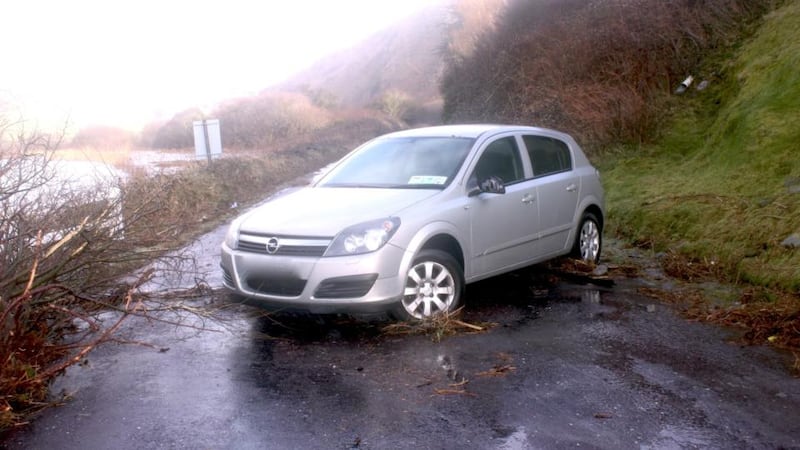In amongst the inevitable photos and videos of cars floating downthe streets of coastal towns, there was an example from west Cork which showed just how resilient our cars can be in the face of raw, furious nature.
Rory Jackson, his wife Celine, their son Aaron and unsuspecting German exchange student Sid were driving in the family's 2006 Astra near the beach at Tragummna (near Skibbereen) on January 6th when a massive wave engulfed the car.
Quickly abandoning the vehicle, family and friend scaled a nearby embankment to get to safety and then were forced to watch as their precious car was swept away by the tide, coming to rest around 10-metres further along.

For more than two hours it sat there, assaulted by waves until the tide finally receded and Mr Jackson glumly went over to assess the damage and arrange for someone to come and tow what he assumed would be a wreck away.
Except it wasn’t a wreck. Far from it. The interior was untouched by water, and even the boot (which contained laptops for the boys’ school and books) was bone dry. Not only that, but the engine compartment seemed to be untouched, and when Jackson plucked up the courage to try turning the key, the car started, first go.
Jackson takes up the story: “I had arranged to have the car towed away for insurance as soon as possible expecting the worst. When the Astra was finally accessible I inspected the car and was pleasantly shocked to discover that the car was completely dry inside and important valuables such as the laptop and school books were undamaged. I checked the engine and battery thinking that there would be severe damage. All was clean and looked OK apart from the debris in between the wheels and underneath. On turning the key it started immediately and I drove it back to my house.”
Sadly for the rest of us, this is something of an isolated, not to say miraculous, case and the fact is that we all need to exercise extreme care and an attention to safety when dealing with cars and floods.
So, what can you do if you ever find yourself in that situation? Well, actually, the best advice is to stand back and let the experts take over. Brian Greene is a Chief Motor Engineer from Assess Ireland, and he told us that the best thing to do with a car left in deep standing water is simply to wait until the flood has receded.
“Where you return to see your car in water, be particularly careful, as it is impossible to determine type of water it is, the depth of the water, whether there are hidden or uncovered objects (manhole covers for example), or even whether the water is still moving.”
Safety first in other words. Leave well enough alone until the flood is gone, and then call in a professional recovery company to get the car out for you. And, of course, call your insurers as they are the experts when it comes to determining whether or not your car can be safely repaired.
There’s another aspect to all these car/liquid interfaces and that’s when it comes to buying second hand. It can’t have entirely escaped your attention that all of those cars which were flooded out will have to be dealt with. Some will eventually be repaired and re-sold.
Now, that shouldn’t cause a knee-jerk reaction of horror that waterlogged cars are being sold to unsuspecting buyers. Many cars which have been flooded out can be safely and professionally repaired and quite reasonably put back into the market. As with so many things, no two floorings are identical, so insurers treat each car on a case-by-case basis, and while many will be written off and sent to the crusher, equally many will simply be dried and repaired.
Of course, there are unscrupulous types out there who will not report a flooded car to their insurers, carry out some quick-and-shoddy repairs and try to offload it. These are the ones to watch for, but a few simple checks should keep you safe.
“If you are considering buying a car in the next few weeks, we would always suggest that the first action should be to perform a vehicle history check. If a vehicle has been written-off for flood damage that should show up in the history report” said Brian Greene.
“It is possible nevertheless that a vehicle was damaged and not reported to an insurance company, and may not be recorded as being written off. In these cases, I would suggest that you consider asking an expert to view the vehicle for you, for less than the cost of your next service it is a very wise investment. We are one of the only companies to continue to offer this service and the findings can be shocking, considering the amount of outlay involved for someone.”
When inspecting a car, if you’re at all suspicious that it was the victim of flooding, there are a few tell-tales. If there are myriad electrical failures (broken switches, inoperative heating fan etc) that could be a sign of water ingress.
Rust or corrosion on the seat runners is another sign as is straightforward wetness - interiors can be dried out, but water can linger under the carpets and in the underlay, so check there. Be suspicious of things like shiny new air and oil filters if the car is not due a service soon and, as a last resort, use your nose. Does the car smell musty or damp inside? Even a thorough drying-out may not eradicate all the damp, so also be suspicious of it smells extremely strongly of air freshener.

















